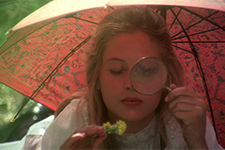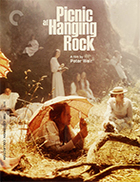Picnic at Hanging Rock (4K UHD)
|  The opening of Peter Weir’s Picnic at Hanging Rock is, like the rest of the film, purposefully and brilliantly enigmatic. Although a work of complete fiction based on a popular 1967 novel by Joan Lindsay, it nonetheless opens with a title card that implies ever so subtly that it is based on an actual incident (just as Lindsay’s novel did), going so far as to give us a precise date (St. Valentine’s Day 1900), a location (Appleyard College, Educational Establishment for Young Ladies), and a specific incident (three young girls disappearing without a trace). Unlike, say, the fake “based on a true story” title card that opens the Joel and Ethan Coen’s Fargo (1996), the opening of Picnic at Hanging Rock doesn’t try to purposefully mislead us, but rather to entice our imaginations with the prospect of truth. It is but the first brick in Weir’s evocative, impressionistic masterwork, drawing us into the story by teasing us with a sense of mystery that will never be resolved and playing that fine line between fiction and reality. The first half of the film takes place over a single day, as the schoolgirls at Appleyard College travel a short distance from their school grounds to picnic in the shadow of Hanging Rock, a “marvel of geology” that juts out of the Central Victoria countryside in Australia. Weir and cinematographer Russell Boyd, with whom he would work again on The Last Wave (1977), Gallipoli (1981), and The Year of Living Dangerously (1982), establish from the very beginning a sense of foreboding by introducing the rock as it emerges from beneath a heavy blanket of slowly dissipating morning mist. Even if we know it is just a lifeless formation created by magma forcing its way through a vent and then congealing more than six million years ago, the manner in which Weir and Boyd photograph it and the interplay of music and heightened natural effects on the soundtrack suggest a presence, a force, something sinister and threatening hiding in the craggy formation, which is enhanced all the more by what appear to be faces in the stone. It is as if the rock is truly alive, intently watching those around it. The threatening nature of the rock, both subtle and obvious, is paralleled by the girls’ school, which is run with stern authority by Mrs. Appleyard (Rachel Roberts). A rigid woman of little humor and even less tolerance for deviation, she is introduced lecturing the girls about their outing, warning them of the dangers the rock presents and how she will not allow any “tomboy foolishness.” Her Victorian sensibilities present an air of repression that hangs over much of the film, although she also evinces a sense of purposeful cruelty that is most evident in her treatment of Sara (Margaret Nelson), an orphan whose tuition bill has not been paid and is therefore forbidden from attending the picnic. As the film is a study in dualities, Mrs. Appleyard’s repressive presence is balanced by Miranda (Anne Lambert), one of the schoolgirls who is best described as ethereal. While Weir photographs all of the girls with a hazy, soft-focus delirium that makes them seem simultaneously angelic and eroticized, Miranda stands apart, a free spirit who appears to be in touch with something outside the confines of this world. Her gaze is rarely directed at others in her presence, but rather wanders skyward, as if she is aware of things that others are not (an early line of dialogue in which she refers to her imminent departure also suggests a kind of preternatural ability to sense the future). Miranda and two other girls disappear while climbing on the rock, as does one of the teachers who goes looking for them. The second half of the film takes place after the disappearances, as those left behind struggle to make sense of the inexplicable event. Mrs. Appleyard tries to maintain control even as parents begin pulling their girls from the school, while Tom (Anthony Llewellyn-Jones), a young man who was also picnicking near the rock with his wealthy parents and was captivated by a fleeting glimpse of Miranda as she made her way toward her fate, becomes obsessed with finding them. The mystery deepens when one of the missing girls, Irma (Karen Robson), is found alive, although in a physical condition that does not necessarily match with her having been lost in the Outback for a week. Of course, she has absolutely no memory of what has happened to her or the others, so her discovery deepens the mystery, rather than resolves it. The film’s social and cultural themes come into sharper focus here, as the forced orderliness of the Appleyard School begins to unravel in the face of something that defies human explanation. While the look of the film has often been described as “nostalgic,” it is quite the opposite, as it is fundamentally critical of the social mores it depicts, from the absurdity of extreme class divisions, to the ridiculousness of Victorian notions of female propriety (the girls are told that they are allowed to remove their gloves while lunching in the hot summer sun, and the first concern when Irma is found is that she is still “intact”). Because the mystery in Picnic at Hanging Rock has no obvious resolution, Weir adopted the style and tone of European art cinema, shifting our attention away from plot points and narrative development by immersing us in a hypnotic atmosphere of sound and image. Some have found the film to be frustrating—even infuriating—because it doesn’t solve the mystery or even leave us with enough clues to draw reasonable conclusions, but it is this very enigma that makes it such a captivating experience (the scene in which Irma is violently accosted by all the other girls at the school who are furious that she can’t tell them what happened must have been a purposeful bit of meta-cinematic commentary on what Weir imagined awaited him from some members of the audience). The missing girls are just a red herring—Hitchcock’s Macguffin—the excuse to weave an impressionistic, haunting mood piece that imbeds in our minds images that never quite dissipate. Weir works in multiple registers throughout the film, giving us images that are quietly erotic (a line of girls all tightening each other’s corsets), sublimely beautiful (Miranda leaping over a brook in slow motion), and ominous (Miranda cutting into a cake with a large butcher knife). The shot in which the girls disappear into the rock, drawn as if in a trance and never to be seen again, while a fourth girl screams in terror, surely ranks as one of the most artfully, unnervingly horrifying moments in a film that is not explicitly a horror film. The very fact that Picnic at Hanging Rock can be viewed as a horror film is testament to its complexity, and it is no small surprise that it played a central role in the renaissance of Australian cinema in the mid-1970s and helped inspire a new subgenre of period films. Yet, despite some attempts at imitation, no one was able to recreate Weir’s indelible mixture of mood and atmosphere, which makes Picnic at Hanging Rock such a truly memorable experience.
Copyright © 2024 James Kendrick Thoughts? E-mail James Kendrick All images copyright © The Criterion Collection | |||||||||||||||||||||||||||||
Overall Rating: 


 (4)
(4)


